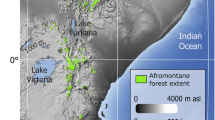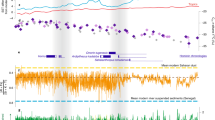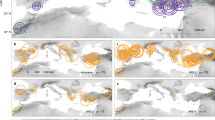East African aridification during the past 8 million years is frequently invoked as a driver of large-scale shifts in vegetation1 and the evolution of new animal lineages, including hominins2,3,4. However, evidence for increasing aridity is debated5 and, crucially, the mechanisms leading to dry conditions are unclear6. Here, numerical model experiments show that valleys punctuating the 6,000-km-long East African Rift System (EARS) are central to the development of dry conditions in East Africa. These valleys, including the Turkana Basin in Kenya, cause East Africa to dry by channelling water vapour towards Central Africa, a process that simultaneously enhances rainfall in the Congo Basin rainforest. Without the valleys, the uplift of the rift system leads to a wetter climate in East Africa and a drier climate in the Congo Basin. Results from climate model experiments demonstrate that the detailed tectonic development of Africa has shaped the rainfall distribution, with profound implications for the evolution of African plant and animal lineages.
This is a preview of subscription content, access via your institution
Access options
Access Nature and 54 other Nature Portfolio journals
Get Nature+, our best-value online-access subscription
$29.99 / 30 days
cancel any time
Subscribe to this journal
Receive 51 print issues and online access
$199.00 per year
only $3.90 per issue
Buy this article
- Purchase on Springer Link
- Instant access to full article PDF
Prices may be subject to local taxes which are calculated during checkout




Similar content being viewed by others
Data availability
Model data arising from this paper used in plotting and the edited high-resolution GLOBE dataset orography files for each experiment are available on publication at https://doi.org/10.5281/zenodo.6956995. ERA5 data were downloaded from https://cds.climate.copernicus.eu/cdsapp#!/home. CHIRPS data are available at https://data.chc.ucsb.edu/products/CHIRPS-2.0/. GPCP data are from https://www.ncei.noaa.gov/access/metadata/landing-page/bin/iso?id=gov.noaa.ncdc:C00979. Data used in base maps for figures are publicly available from https://www.naturalearthdata.com/ and plotted with Cartopy (https://github.com/SciTools/cartopy/archive/v0.11.2.tar.gz). The UK Met Office Unified Model is available for use under license. For further information on how to apply for a license, see http://www.metoffice.gov.uk/research/modelling-systems/unified-model.
Code availability
Code for producing figures is available on publication at https://doi.org/10.5281/zenodo.6956995.
References
Bobe, R. The evolution of arid ecosystems in eastern Africa. J. Arid. Environ. 66, 564–584 (2006).
deMenocal, P. B. African climate change and faunal evolution during the Pliocene–Pleistocene. Earth Planet. Sci. Lett. 220, 3–24 (2004).
Maslin, M. A., Shultz, S. & Trauth, M. H. A synthesis of the theories and concepts of early human evolution. Philos. Trans. R. Soc. B Biol. Sci. 370, 20140064 (2015).
Vrba, E. S. in Evolutionary History of the “Robust” Australopithecines (ed. Grine, F. E.) 405–426 (Aldine de Gruyter, 1988).
Blumenthal, S. A. et al. Aridity and hominin environments. Proc. Natl Acad. Sci. USA 114, 7331–7336 (2017).
Levin, N. E. Environment and climate of early human evolution. Annu. Rev. Earth Planet. Sci. 43, 405–429 (2015).
Trewartha, G. T. The Earth’s Problem Climates (Univ. Wisconsin Press, 1961).
Yang, W., Seager, R., Cane, M. A. & Lyon, B. The annual cycle of East African precipitation. J. Clim. 28, 2385–2404 (2015).
Nicholson, S. E. Climate and climatic variability of rainfall over eastern Africa. Rev. Geophys. 55, 590–635 (2017).
Washington, R., James, R., Pearce, H., Pokam, W. M. & Moufouma-Okia, W. Congo Basin rainfall climatology: can we believe the climate models? Philos. Trans. R. Soc. B Biol. Sci. 368, 20120296 (2013).
Ring, U. The East African rift system. Austrian J. Earth Sci. 107, 132–146 (2014).
Sepulchre, P. et al. Tectonic uplift and Eastern Africa aridification. Science 313, 1419–1423 (2006).
Betzler, C. et al. The abrupt onset of the modern South Asian Monsoon winds. Sci. Rep. 6, 29838 (2016).
Indeje, M., Semazzi, F. H. M., Xie, L. & Ogallo, L. J. Mechanistic model simulations of the East African climate using NCAR regional climate model: influence of large-scale orography on the Turkana low-level jet. J. Clim. 14, 2710–2724 (2001).
Nicholson, S. The Turkana low-level jet: mean climatology and association with regional aridity. Int. J. Climatol. 36, 2598–2614 (2016).
Vizy, E. K. & Cook, K. H. Observed relationship between the Turkana low-level jet and boreal summer convection. Clim. Dyn. 53, 4037–4058 (2019).
Munday, C., Washington, R. & Har, N. African low-level jets and their importance for water vapor transport and rainfall. Geophys. Res. Lett. 48, e2020GL090999 (2021).
Chorowicz, J. The East African rift system. J. Afr. Earth Sci. 43, 379–410 (2005).
Viste, E. & Sorteberg, A. Moisture transport into the Ethiopian highlands. Int. J. Climatol. 33, 249–263 (2013).
Spavins‐Hicks, Z. D., Washington, R. & Munday, C. The Limpopo Low‐Level Jet: mean climatology and role in water vapor transport. J. Geophys. Res. Atmos. 126, e2020JD034364 (2021).
Barimalala, R., Blamey, R. C., Desbiolles, F. & Reason, C. J. C. The influence of southeastern African river valley jets on regional rainfall. Clim. Dyn. 57, 2905–2920 (2021).
Slingo, J., Spencer, H., Hoskins, B., Berrisford, P. & Black, E. The meteorology of the Western Indian Ocean, and the influence of the East African Highlands. Philos. Trans. R. Soc. A Math. Phys. Eng. Sci. 363, 25–42 (2005).
Prömmel, K., Cubasch, U. & Kaspar, F. A regional climate model study of the impact of tectonic and orbital forcing on African precipitation and vegetation. Palaeogeogr. Palaeoclimatol. Palaeoecol. 369, 154–162 (2013).
Jung, G., Prange, M. & Schulz, M. Influence of topography on tropical African vegetation coverage. Clim. Dyn. 46, 2535–2549 (2016).
DeMenocal, P. B. Plio-Pleistocene African climate. Science 270, 53–59 (1995).
Cerling, T. E. et al. Woody cover and hominin environments in the past 6 million years. Nature 476, 51–56 (2011).
Maslin, M. A. et al. East African climate pulses and early human evolution. Quat. Sci. Rev. 101, 1–17 (2014).
Trauth, M. H. et al. Northern Hemisphere Glaciation, African climate and human evolution. Quat. Sci. Rev. 268, 107095 (2021).
Herbert, T. D. et al. Late Miocene global cooling and the rise of modern ecosystems. Nat. Geosci. 9, 843–847 (2016).
Hodell, D. A. & Channell, J. E. T. Mode transitions in Northern Hemisphere glaciation: co-evolution of millennial and orbital variability in Quaternary climate. Clim. Past 12, 1805–1828 (2016).
Wilks, D. The stippling shows statistically significant grid points. Bull. Am. Meteorol. Soc. 97, 2263–2274 (2016).
Tucker, S. O. et al. Evaluation of a new 12 km regional perturbed parameter ensemble over Europe. Clim. Dyn. 58, 879–903 (2022).
Wood, N. et al. An inherently mass-conserving semi-implicit semi-Lagrangian discretization of the deep-atmosphere global non-hydrostatic equations. Q. J. R. Meteorol. Soc. 140, 1505–1520 (2014).
Gregory, D. & Rowntree, P. R. A mass flux convection scheme with representation of cloud ensemble characteristics and stability-dependent closure. Mon. Weather Rev. 118, 1483–1506 (1990).
Davies, T. Lateral boundary conditions for limited area models. Q. J. R. Meteorol. Soc. 140, 185–196 (2014).
Dee, D. P. et al. The ERA-Interim reanalysis: configuration and performance of the data assimilation system. Q. J. R. Meteorol. Soc. 137, 553–597 (2011).
Reynolds, R. W. et al. Daily high-resolution-blended analyses for sea surface temperature. J. Clim. 20, 5473–5496 (2007).
Funk, C. et al. The climate hazards infrared precipitation with stations—a new environmental record for monitoring extremes. Sci. Data 2, 150066 (2015).
Adler, R. F. et al. The Global Precipitation Climatology Project (GPCP) monthly analysis (new version 2.3) and a review of 2017 global precipitation. Atmosphere 9, 138 (2018).
Creese, A. & Washington, R. Using qflux to constrain modeled Congo Basin rainfall in the CMIP5 ensemble. J. Geophys. Res. Atmos. 121, 13,415–13,442 (2016).
Haensler, A., Saeed, F. & Jacob, D. Assessing the robustness of projected precipitation changes over central Africa on the basis of a multitude of global and regional climate projections. Clim. Change 121, 349–363 (2013).
Hersbach, H. et al. The ERA5 global reanalysis. Q. J. R. Meteorol. Soc. 146, 1999–2049 (2020).
Hastings, D. A. et al. The Global Land One-kilometer Base Elevation (GLOBE) Digital Elevation Model, Version 1.0 (National Oceanic and Atmospheric Administration, 1999); http://www.ngdc.noaa.gov/mgg/topo/globe.html.
Acknowledgements
We acknowledge the input from and useful discussions with J. Lee-Thorp and R. Bobé (both Oxford University). This article is an output from the REACH programme, financed by UK Aid from the UK Foreign, Commonwealth and Development Office (FCDO) for the benefit of developing countries (programme code 201880). However, the views expressed and information contained in it are not necessarily those of or endorsed by the FCDO, which can accept no responsibility for such views or information or for any reliance placed on them.
Author information
Authors and Affiliations
Contributions
C.M. designed and ran the model experiments and wrote the manuscript. N.S. helped set up and run the model experiments and wrote part of the Methods section. R.W. contributed to the design of the experiments and edited the manuscript. R.G.J. contributed to the experimental design and edited the manuscript.
Corresponding author
Ethics declarations
Competing interests
The authors declare no competing interests.
Peer review
Peer review information
Nature thanks Thierry C. Fotso-Nguemo and the other, anonymous, reviewer(s) for their contribution to the peer review of this work.
Additional information
Extended data
is available for this paper at https://doi.org/10.1038/s41586-022-05662-5.
Publisher’s note Springer Nature remains neutral with regard to jurisdictional claims in published maps and institutional affiliations.
Extended data figures and tables
Extended Data Fig. 1 Water vapour transport in control and reanalysis data.
The arrows show the direction and strength at which atmospheric-column integrated water vapour is being transported (kg m−1 s−1) in the control experiment (a) and ERA5 (b). Shading gives the IWVT magnitude (kg m−1 s−1) (see Methods). The East African region we use to evaluate the moisture budget is bounded by the red line in a. ERA5 data42 are available at https://cds.climate.copernicus.eu/cdsapp#!/home.
Extended Data Fig. 2 Evaluation of rainfall in the control simulation.
Annual rainfall (mm year−1) in the control (a), CHIRPS (b) and GPCP version 2.2 (c). CHIRPS38 data are available at https://data.chc.ucsb.edu/products/CHIRPS-2.0/. GPCP data39 are from https://www.ncei.noaa.gov/access/metadata/landing-page/bin/iso?id=gov.noaa.ncdc:C00979.
Rights and permissions
Springer Nature or its licensor (e.g. a society or other partner) holds exclusive rights to this article under a publishing agreement with the author(s) or other rightsholder(s); author self-archiving of the accepted manuscript version of this article is solely governed by the terms of such publishing agreement and applicable law.
About this article
Cite this article
Munday, C., Savage, N., Jones, R.G. et al. Valley formation aridifies East Africa and elevates Congo Basin rainfall. Nature 615, 276–279 (2023). https://doi.org/10.1038/s41586-022-05662-5
Received:
Accepted:
Published:
Issue Date:
DOI: https://doi.org/10.1038/s41586-022-05662-5
Comments
By submitting a comment you agree to abide by our Terms and Community Guidelines. If you find something abusive or that does not comply with our terms or guidelines please flag it as inappropriate.



